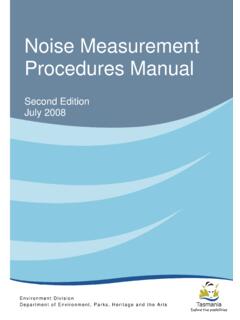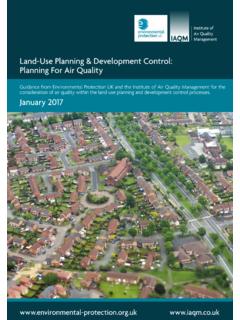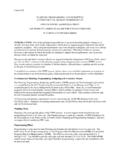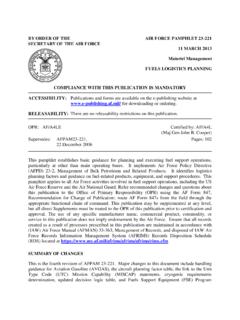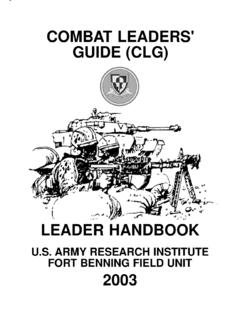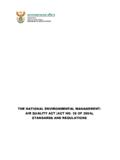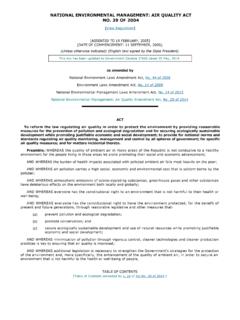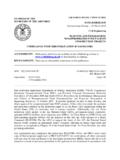Transcription of ENVIRONMENT PROTECTION POLICY (AIR QUALITY)
1 ENVIRONMENT PROTECTION . POLICY ( air quality ) 2004. ENVIRONMENT Division Department of Tourism, Arts and the ENVIRONMENT I, the Administrator in and over the State of Tasmania and its Dependencies in the Commonwealth of Australia, acting with the advice of the Executive Council and on the recommendation of the Minister, make the following ENVIRONMENT PROTECTION POLICY under section 96K of the Environmental Management and Pollution Control Act 1994. Dated 13 December 2004. PETER G UNDERWOOD. Administrator By His Excellency's Command, JUDY JACKSON. Minister for ENVIRONMENT and Planning This ENVIRONMENT PROTECTION POLICY came into effect on 1 June 2005. ENVIRONMENT PROTECTION POLICY ( air quality ) 2004. ENVIRONMENT Division Department of Tourism, Arts and the ENVIRONMENT GPO Box 1751.
2 Hobart Tasmania 7001. Australia Published in June 2005 by the Department of Primary Industries, Water and ENVIRONMENT , GPO Box 44, Hobart, Tasmania 7001, Australia Reprinted August 2007. ISBN 0 7246 6337 1. ENVIRONMENT PROTECTION POLICY ( air quality ) 2004 2. TABLE OF CONTENTS. PART 1 - 5. Authority .. 5. Short title and commencement .. 5. Interpretation .. 5. PART 2 - APPLICATION AND 7. Application of POLICY .. 7. Objective of POLICY .. 7. PART 3 - ENVIRONMENTAL VALUES AND STANDARDS .. 7. Environmental values .. 7. Ambient air quality standards .. 8. Achieving Air NEPM standards .. 8. PART 4 - MANAGING POINT SOURCES OF AIR CONTAMINANTS .. 8. Point sources to be managed and 8. Waste avoidance .. 8. Managing and setting regulatory controls for unavoidable emissions .. 9. Improving the performance of current emission 10.
3 11. Air pollution dispersion modelling .. 11. Monitoring of emissions and their effects .. 12. PART 5 - MANAGING DIFFUSE SOURCES OF AIR CONTAMINANTS .. 12. Management of diffuse sources of air pollution .. 12. Planned Burning .. 12. SCHEDULE 1 - IN-STACK CONCENTRATIONS .. 14. SCHEDULE 2 DESIGN CRITERIA .. 17. SCHEDULE 3 - ODOUR CRITERIA .. 21. 3 ENVIRONMENT PROTECTION POLICY ( air quality ) 2004. ENVIRONMENT PROTECTION POLICY ( air quality ) 2004 4. Part 1 - PRELIMINARY. Authority 1. This ENVIRONMENT PROTECTION POLICY is made pursuant to the provisions of section 96A-96O of the Environmental Management and Pollution Control Act 1994. The types of provisions that may be included in an ENVIRONMENT PROTECTION POLICY are specified in section 96D of the Act. Short title and commencement 2.
4 This ENVIRONMENT PROTECTION POLICY may be cited as the ENVIRONMENT PROTECTION POLICY ( air quality ) 2004. This POLICY takes effect on the later of the following days . (a) 1 June 2005;. (b) the date after it has been approved by both Houses of Parliament in accordance with section 96K of the Act. Interpretation 3. (1) In this POLICY , unless the contrary intention appears - accepted modern technology means technology which has a demonstrated capacity to achieve the desired emission concentration in a cost-effective manner, takes account of cost-effective engineering and scientific developments and pursues opportunities for waste minimisation;. Act means the Environmental Management and Pollution Control Act 1994;. Air NEPM means the National ENVIRONMENT PROTECTION Measure for Ambient air quality made by the National ENVIRONMENT PROTECTION Council on 26th June 1998, as amended from time to time.
5 Airshed means an area that is defined by natural or topographic features affecting air quality . Once a substance is emitted into an airshed, it is contained therein for a reasonable period of time;. ambient air ENVIRONMENT means the external air ENVIRONMENT and does not include the air ENVIRONMENT inside buildings or structures;. Appeal Tribunal means the Resource Management and Planning Appeal Tribunal established by the Resource Management and Planning Appeal Tribunal Act 1993;. best practice environmental management has the same meaning as in the Act;. Board has the same meaning as in the Act;. diffuse sources of air pollution means a number of dispersed sources from which pollution entering the ENVIRONMENT has the potential to combine with other such sources, and includes pollution from domestic solid fuel burning appliances, 5 ENVIRONMENT PROTECTION POLICY ( air quality ) 2004.
6 Motor vehicles, backyard burning and planned burning (as defined in clause 17(1));. Director means the Director of Environmental Management holding office under section 18 of the Act;. environmental harm has the same meaning as in the Act;. environmental nuisance has the same meaning as in the Act;. industrial location means: (a) premises used for the purpose of providing water, sewerage, drainage, electricity, gas, telecommunications, passenger transport, or similar services;. (b) premises used by aircraft or ships or as a freight yard;. (c) premises used for the carrying out of any process for and incidental to - (i) production, processing or manufacture;. (ii) dismantling or breaking-up goods or equipment;. (iii) repairing, cleaning or servicing of equipment or buildings, but not including on-site work on buildings.
7 (iv) packaging; or (v) outdoor storage not in association with any other activity on the site, but not including a vehicle sales yard;. (d) a mine within the meaning of the Mineral Resources Development Act 1995;. (e) without limiting item 4, any premises used for sand, soil, gravel, clay, limestone or rock excavation;. (f) waste disposal sites and premises used for any process for and incidental to the treatment or disposal of waste;. in-stack concentration means the concentration of a pollutant within and prior to its emission from a chimney stack or other point of emission, as measured in accordance with the relevant Australian Standard or other procedure approved by the Director;. level 1 activity has the same meaning as in the Act;. level 2 activity has the same meaning as in the Act.
8 Level 3 activity has the same meaning as in the Act;. material environmental harm has the same meaning as in the Act;. mg/m3 means milligrams per cubic metre referenced to a temperature of 0 degrees Celsius and an absolute pressure of kilopascals;. Minister means the Minister responsible for the administration of the Act;. NEPM means a national environmental PROTECTION measure within the meaning of the National ENVIRONMENT PROTECTION Council (Tasmania) Act 1995;. ENVIRONMENT PROTECTION POLICY ( air quality ) 2004 6. point source of air pollution means a discrete, stationary, industrial location which is a source of pollution by one or more chimneys or other points of emission, but does not include a stationary motor vehicle, train or marine vessel;. pollutant has the same meaning as in the Act.
9 Pollute has the same meaning as in the Act;. ppm means parts per million by volume;. regulatory authority means any authority that has a statutory power to approve or regulate the environmental effects of an activity. For level 1 activities the regulatory authority will be the relevant planning authority and for level 2. activities, the Director or the Board. There are some activities that are neither level 1 or level 2 activities and the regulatory authority in such instances is likely to be the relevant planning authority;. responsible person means the person responsible for an activity which emits or is likely to emit pollutants to the air;. serious environmental harm has the same meaning as in the Act;. g/m3 means micrograms per cubic metre referenced to a temperature of 0 degrees Celsius and an absolute pressure of kilopascals; and waste has the same meaning as in the Act.
10 (2) In this POLICY , words in the singular shall include the plural and words in the plural shall include the singular. Part 2 - APPLICATION AND OBJECTIVES. Application of POLICY 4. This POLICY applies to the ambient air ENVIRONMENT of Tasmania. Objective of POLICY 5. (1) The objective of this POLICY is to further the objectives of the Act in relation to the ambient air ENVIRONMENT of Tasmania. (2) The objectives of the Act are set out in Schedule 1 to the Act. Part 3 - ENVIRONMENTAL VALUES AND STANDARDS. Environmental values 6. (1) Environmental values are the values or uses of the ENVIRONMENT that are to be protected. (2) The environmental values to be protected under this POLICY are . (a) the life, health and well-being of humans at present and in the future;. 7 ENVIRONMENT PROTECTION POLICY ( air quality ) 2004.



